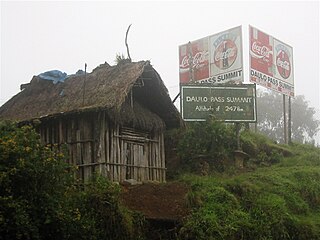
The Papua New Guinea Defence Force (PNGDF) is the military organisation responsible for the defence of Papua New Guinea. It originated from the Australian Army land forces of the territory of Papua New Guinea before independence, coming into being in January 1973 and having its antecedents in the Pacific Islands Regiment. The PNGDF is a small force, numbering around 3,600 personnel, and consists of a Land Element, an Air Element and a Maritime Element. It is a joint force tasked with defending Papua New Guinea and its territories against external attack, as well as having secondary functions including national-building and internal security tasks.

The Highlands Highway, sometimes known as the Okuk Highway, is the main land highway in Papua New Guinea. It connects several major cities and is vital for the movement of people and goods between the populous Highlands region and the coast.

Southern Highlands is a province in Papua New Guinea. Its provincial capital is the town of Mendi. According to Papua New Guinea's national 2011 census, the total population of Southern Highlands is 515,511 spread across 15,089 square kilometers (5,826 sq mi).

Mount Hagen is the third largest city in Papua New Guinea, with a population of 46,250. It is the capital of the Western Highlands Province and is located in the large fertile Wahgi Valley in central mainland Papua New Guinea, at an elevation of 1,677 m (5,502 ft).

Wabag is the capital of Enga Province, Papua New Guinea. It is the least populous provincial capital in the country. It is on the Lai River; the Highlands Highway passes through the town, between Mount Hagen and Porgera. Europeans first visited the site in 1938-39 A radio camp and airstrip were established in 1938-39 but restrictions on transportation and the surrounding land's infertility long inhibited Wabag's development.

This page is a list of districts of Papua New Guinea.
For administrative purposes, Papua New Guinea (PNG) is divided into administrative divisions called regions and provinces. Papua New Guinea is divided into four regions and 22 province-level divisions: 20 provinces plus the autonomous region (Bougainville) and the National Capital District.

The New Guinea Highlands, also known as the Central Range or Central Cordillera, is a long chain of mountain ranges on the island of New Guinea, including the island's tallest peak, Puncak Jaya, Indonesia, 16,024 ft (4,884 m), the highest mountain in Oceania. The range is home to many intermountain river valleys, many of which support thriving agricultural communities. The highlands run generally east-west the length of the island, which is divided politically between Indonesia in the west and Papua New Guinea in the east.

The Engan, or more precisely Enga – Southern Highland, languages are a small family of Papuan languages of the highlands of Papua New Guinea. The two branches of the family are rather distantly related, but were connected by Franklin and Voorhoeve (1973).

Kandep District is one of the five Districts of Enga Province in Papua New Guinea. It is located in the southern part of Wabag, capital town of Enga. Kandep shares land borders between Laiagam-Porgera district, Wabag, and Wapenamanda District. It also shares borders with Southern Highlands, Western Highlands and the newly breakaway Hela Province. Kandep is accessible by road, and the Kandep - Laiagam Road links to Wabag which is 3 hours drive back and forth. The Kandep - Mendi road, a newly sealed road can be used to travel to Mt. Hagen via Mendi. The Kandep - Magarima Road is also connected.

General elections were held in Papua New Guinea from 23 June until around 13 July 2012, after being postponed by a further week to allow for security personnel to crisscross the country, particularly the highland provinces. The elections followed controversy over incomplete electoral rolls and a constitutional crisis caused by a dispute over the office of prime minister between Michael Somare and Peter O'Neill.
Kandep Rural LLG is one of two LLGs of the Kandep District of Enga Province, Papua New Guinea. It is located in southern Wabag, the capital town of Enga Province. Kandep shares land borders with Laiagam - Porgera, Wabag, and Wapenimanda District, along with additional land borders between the Southern Highlands, the Western Highlands provinces, and the newly Provinces.
Wage Rural LLG in Kandep District is one of the two Local-Level Governments (LLGs) of the Kandep District of Enga Province, Papua New Guinea. It is located at Southern part of Wabag, capital town of [Enga Province]. Kandep shares land borders between Laiagam - Porgera, Wabag, and Wapenimanda District. Also shares borders with Southern Highland, Western highlands and newly breakaway Provinces of Hela.
Robert Sandan Ganim is a Papua New Guinean politician. He was a member of the National Parliament of Papua New Guinea from 2012 to 2017, representing the electorate of Wabag Open for the People's Party (2012-2017) and the People's National Congress (2017).
Wabag Rural LLG is a local-level government (LLG) of Enga Province, Papua New Guinea.
Wabag Urban LLG is a local-level government (LLG) of Enga Province, Papua New Guinea.

Rodrick Tai is a Papua New Guinean professional rugby league footballer who plays as a centre for the Warrington Wolves in the Super League and Papua New Guinea at international level.
Sir Tei Abal was a member of the parliament of Papua New Guinea (PNG) between 1964 and 1982, during which time he both served as a government minister in several positions and was leader of the opposition. He was known as an unsuccessful advocate of slowing down the process of PNG's Independence, because he considered that the population from the Highlands areas, of which he was one, were unready for independence.
Events in the year 2024 in Papua New Guinea.
On 24 May 2024, a landslide occurred in Mulitaka, Papua New Guinea. Estimates of the number of deaths have ranged widely, from 160 to 2,000. A week later, eleven bodies had been recovered, but many more people are missing, including about 2,500 in the villages of Kaokalam and Tulipana alone.













